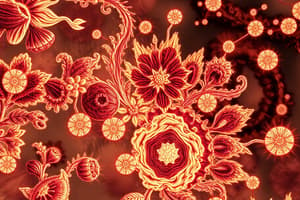Podcast
Questions and Answers
What are the four main components of the Gram staining procedure?
What are the four main components of the Gram staining procedure?
The four main components are primary stain (Crystal violet), mordant (Gram's Iodine), decolorizer (acetone or Ethanol), and counter stain (safranin or neutral red).
Describe the purpose of heat-fixing a smear before Gram staining.
Describe the purpose of heat-fixing a smear before Gram staining.
Heat-fixing attaches the bacteria to the slide and kills them, preventing them from washing away during the staining process.
Explain the significance of using the right amount of decolorizer during Gram staining.
Explain the significance of using the right amount of decolorizer during Gram staining.
Using the right amount of decolorizer is crucial because over-decolorization may result in Gram-positive bacteria appearing Gram-negative.
What should be done if a sample is taken from a liquid culture when preparing the smear?
What should be done if a sample is taken from a liquid culture when preparing the smear?
Why is it recommended to start observing a slide under the lowest magnification before increasing to higher powers?
Why is it recommended to start observing a slide under the lowest magnification before increasing to higher powers?
The primary stain used in Gram staining is ______ violet.
The primary stain used in Gram staining is ______ violet.
A ______ is used after the primary stain to fix the crystal violet and enhance staining.
A ______ is used after the primary stain to fix the crystal violet and enhance staining.
The decolorizer used in the Gram staining process is typically ______ or ethanol.
The decolorizer used in the Gram staining process is typically ______ or ethanol.
After decolorization, the slide is flooded with ______ stain as a counter stain.
After decolorization, the slide is flooded with ______ stain as a counter stain.
Heat-fixing the smear is done by passing the slide over a ______ flame.
Heat-fixing the smear is done by passing the slide over a ______ flame.
Flashcards
Gram Staining
Gram Staining
A differential staining technique used to categorize bacteria based on the structure of their cell walls.
Primary Stain
Primary Stain
Crystal violet or Gentian violet used to stain all cells initially in the Gram staining procedure.
Mordant
Mordant
Gram's Iodine, used to improve the binding of the primary stain to the cell wall
Decolorizer
Decolorizer
Signup and view all the flashcards
Counter Stain
Counter Stain
Signup and view all the flashcards
What type of bacteria is stained purple?
What type of bacteria is stained purple?
Signup and view all the flashcards
What type of bacteria is decolorized?
What type of bacteria is decolorized?
Signup and view all the flashcards
What is the purpose of the mordant?
What is the purpose of the mordant?
Signup and view all the flashcards
Why is heat-fixing necessary?
Why is heat-fixing necessary?
Signup and view all the flashcards
What is the last step of Gram staining?
What is the last step of Gram staining?
Signup and view all the flashcards
Study Notes
Gram Stain Procedure
-
Materials:
- Bunsen burner
- Clean microscope slide
- Water
- Slide dryer
- Inoculating loop
- Agar plate cultures of P. aeruginosa and Staphylococcus aureus
- Sample A and B (per student)
- Crystal violet or Gentian violet
- Gram's Iodine
- Acetone or Ethanol (decolorizer)
- Safranin or neutral red (counterstain)
-
Specimen Preparation:
- Divide the slide into three sections (diagram not included in text).
- Place a drop of water on the slide.
- Using an inoculating loop, obtain a colony from sample or culture and suspend in water to make a milky suspension.
- If the specimen is from liquid culture, skip the water drop step.
- Air-dry the smear.
- Heat-fix the smear by gently passing the slide over the burner flame 2-3 times. Test slide temperature by touching the back of your hand.
- Place specimen(s) in designated areas on the slide as noted by instructions or diagrams.
-
Gram Stain Procedure:
- Flood the slide with crystal violet stain (45-60 seconds).
- Wash with running tap water.
- Flood with Gram's iodine (45-60 seconds).
- Flood with decolorizer (95% acetone/alcohol). Watch for rinsing from the cells (4-6 seconds). Avoid over-decolorizing.
- Wash with running tap water.
- Flood with Safranin counterstain (45-60 seconds).
- Wash with running tap water.
- Dry with filter paper.
- Observe under the microscope, starting at the lowest magnification without oil immersion. Only use oil immersion with the x100 objective.
Studying That Suits You
Use AI to generate personalized quizzes and flashcards to suit your learning preferences.




